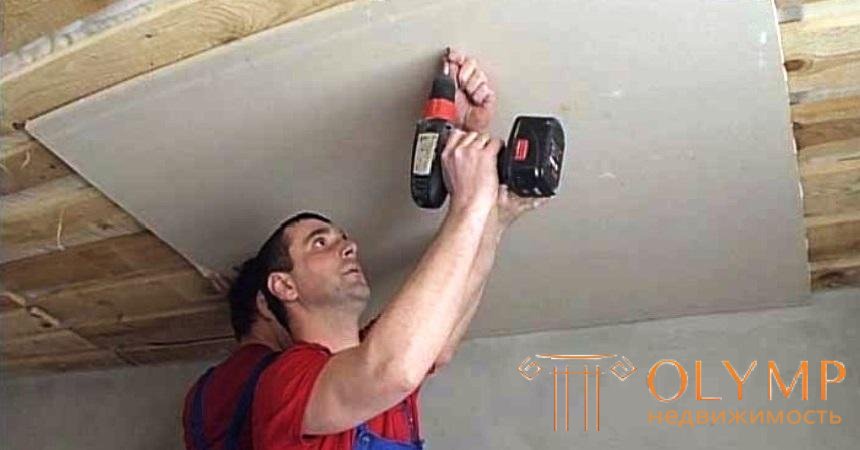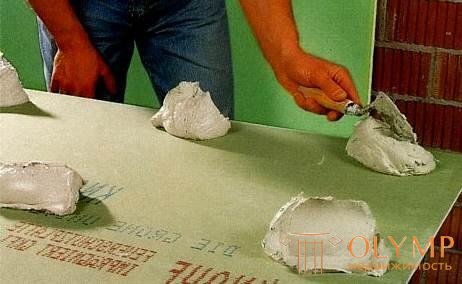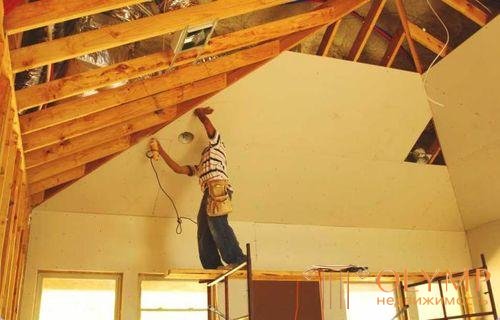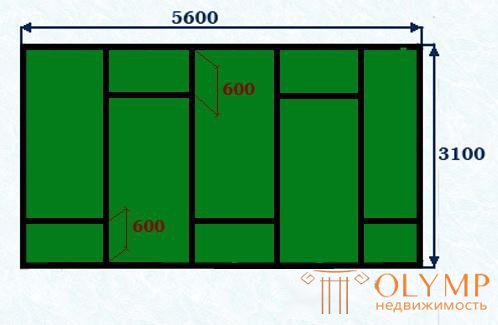
Quite often for the alignment of the ceiling using drywall, which is mounted on a specially created frame. This method is very common. However, there are cases when the ceiling is leveled with drywall without a frame. It is clear that if the height difference is quite large (more than 4 cm), then the framework can no longer be done. Ideally, the height difference should not exceed 2 cm so that the frameless method of fixing the drywall can be applied.
Content:

Frameless method is used in most cases with flat ceilings.
Drywall is fixed to the ceiling without a frame for the reason that this method has certain positive aspects that are pushing to implement it. What advantages are we talking about?
The disadvantages of this method of attachment are much more than advantages. You need to take them all into account before you make your final choice. The disadvantages include:
The disadvantages of the frameless method are very serious, so it is not used very often. We need to weigh the pros and cons, to understand whether it is possible to mount the GCR without profiles in your particular case. Perhaps the ceiling is almost perfect, there is no need to move the chandelier, and there is no need for warming. Then the use of the frame may seem redundant. There are also cases in which it is not needed. For example, when drywall is mounted on a wooden ceiling without a frame. In this embodiment, the ceiling is already smooth and profiles are not needed. But such situations are extremely rare.

To the drywall wooden ceiling attached to the screws without the use of glue
The entire process of installing the gypsum board to the ceiling without a frame is reduced to finally obtaining the same level surface as in the case with the use of profiles. For greater convenience, beacons can be used so that the surface does not turn out to be a curve. Of course, you can do without them, but in this case you will have to devote quite a lot of time to each sheet so that it lays as smoothly as possible. Before you attach drywall to the ceiling without profiles, you need to decide whether to use beacons or not.
With small squares (toilet, pantry, balcony) you can work without beacons. If the ceiling area is large (bedroom, hall), then it is better to use lighthouses.
The above described the principle of working with adhesives (when the gypsum board is mounted on a special solution). However, its installation can be done in another way. It is permissible to fix gypsum screws directly to the ceiling. Typically, this method is resorted to when the ceiling is made of wood so that the screws securely hold.
Drywall to the ceiling without a frame can be mounted in different ways. Very often used adhesives, due to which GCR attached to the surface. However, it is extremely difficult to work. Not a problem to dilute the adhesive solution to the desired consistency, because the instruction is on the package. It is much more difficult to glue drywall, and even over his head.

Easier to put glue on drywall and not on the ceiling
The glue itself must be applied around the perimeter, and then in the center of the sheet. The distance between the adhesive applied to the drywall should be 40 cm. There is no need to spread the adhesive on the very edge, because it will protrude outside when pressed.
Before you glue the drywall to the ceiling without profiles, you need to prepare the surface. It is first cleaned with a spatula of paint and whitewash. Also should loose loose putty. If wallpapers were used, they must be removed completely. Removes all dirt and grease stains (remain after painting). Only after that the ceiling can be primed. It is most convenient to do this with a roller on a telescopic stick. So you can prime the ceiling, standing on the floor.
It is necessary to use a special primer that is compatible with the glue that will be used for mounting the gypsum board. Be sure to apply two layers of soil for better adhesion.
Glued cardboard sheets smeared with adhesive are lifted up and pressed. They are pressed down with a certain force to be on the same level. We'll have to try very hard so that all sheets lie flat. Especially if the ceiling has a large curvature.
It is better to work together so that the drywall can be raised normally. When working independently, you should make yourself supports (for example, to combine the profile in the shape of the letter “T”) so that you can rest the gypsum board on them when lifting.
Many are afraid to use glue, putty, mastic and other mixtures for fastening. There is a risk that drywall to the ceiling without a frame, attached in this way, may disappear. Like, over time, everything will crack and the gypsum falls directly on the head. If you pick up a bad adhesive mixture and primer, then this option is quite real.
With such a ceiling there is no need to use a frame. When the ceiling is made of wood, it is usually already flat. However, its appearance can be transformed. For this purpose, use drywall. Since nothing needs to be aligned, it is fixed without using a profile, but with the help of screws. In fact, the sheets are simply screwed to the ceiling with screws.
Installation of drywall on a wooden ceiling without a frame is not something difficult, because such repairs are easy to do yourself. In this case, the height of the room does not decrease, and the cost of repairs is minimal. With the help of props can be carried out installation independently. However, the ceiling of the tree can be deformed and cause damage to drywall. In particular, the seams may diverge.

The wood must shrink before it is sheathed with plasterboard
Installation is carried out using wood screws. GKL is screwed in the same way as in the case with the use of profiles.
Often the repair work is a mechanical process that does not require much imagination. However, in some cases it is an extremely important element of the work process. There may be several answers to the question of how to fix drywall to the ceiling without a profile.
There is one more method, which is extremely rarely resorted to, but still it is worth telling about it. Perhaps, he will push on some interesting ideas that he will be able to implement with a minimum of experience.
The ceiling is laid out and drilled under the dowel with a step of 20 cm. The entire ceiling is laid out so that the distance between the strips is 40 cm (as when installing the frame). When everything is laid out, the holes are drilled and the dowels are inserted, you need to mark up the sheets of drywall. It is necessary to mark all the points where the gypsum board will be attached to the ceiling with the help of screws and dowels. All these tags need to be drilled under the sweat, so that the heads of the screws drown, and not protruded. Since the sheets will not be pressed tightly to the base, the screws will not go deep into the drywall themselves.

The option of mounting sheets to the ceiling
Sheets rise, and then through them the screws are screwed into the dowels, but not completely. This is how all sheets are baited, and then the ceiling is leveled. It can not do without a laser level. Using screws of different lengths and twisting them not to the end, you can mount the drywall to the ceiling without a frame.
This method can align large differences in height of the ceiling at its low level. However, the process is very difficult, because not everyone will be able to pre-cut the sheets to the desired size and map out all the places on the gypsum board and on the ceiling where the screws will be fastened. Few people want to drill future holes to make a screw hole. It is also not easy to constantly move around the perimeter in order to constantly tighten and loosen the screws, thereby leveling the ceiling. It is worth resorting to this method only if the curvature of the ceiling is too large and you absolutely do not want to use a frame made of profiles.
Что бы оставить комментарий войдите
Комментарии (0)